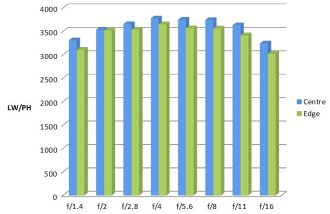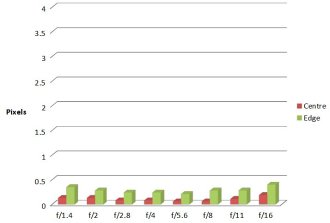Nikon AF-S Nikkor 105mm f/1.4E ED Review
Nikon AF-S Nikkor 105mm f/1.4E ED Performance
Sharpness is exemplary. Centrally, the figures are excellent from f/1.4 through to f/11. Diffraction at f/16 does tip the description to being very good, but there's little in it and the fall off is very well controlled. However, it is worth saying that very good as a term means just that and is a high standard in itself.
At the edges, sharpness is already very good at f/1.4, and excellent from f/2 through to f/11. Again, diffraction starts to reduce the figures to a very good standard at f/16. In practice, all apertures are perfectly usable.
How to read our charts
The blue column represents readings from the centre of the picture frame at the various apertures and the green is from the edges.The scale on the left side is an indication of actual image resolution as LW/PH and is described in detail above. The taller the column, the better the lens performance.
For this review, the lens was tested on a Nikon D810 using Imatest.
CA (Chromatic Aberration) is very low, especially at the centre. Even at the edges the figures are very impressive. This results in clean, clear images, free of fringing even in extreme situations. If desired, any minor residual CA could be eliminated in software, but it is unlikely to be necessary.
How to read our charts
Chromatic aberration is the lens' inability to focus on the sensor or film all colours of visible light at the same point. Severe chromatic aberration gives a noticeable fringing or a halo effect around sharp edges within the picture. It can be cured in software.Apochromatic lenses have special lens elements (aspheric, extra-low dispersion etc) to minimize the problem, hence they usually cost more.
For this review, the lens was tested on a Nikon D810 using Imatest.
The lens is quite complex, but the coatings are clearly up to the job. There is no hint of flare whatsoever.
Distortion is also well controlled, measuring +0.892% pincushion. For most purposes this is fine, but if needed it would be easy to eliminate in software. It is an excellent result.
A major use of this lens is portraiture, so the bokeh is of especial interest. The telephoto focal length, the rounded diaphragm and of the course the optical design all contribute to making a very smooth and pleasant effect. There is no sign of raggedness and the lens fulfils its promise in style.
Value For Money
The AF-S Nikkor 105mm f/1.4E ED is priced at £2149, a not insubstantial amount. Its performance is not in question, but the high cost is a result of that bright maximum aperture. If that is needed, then there is no competition and the choice is clear.
There is also available the Nikon 105mm f/2 D AF DC lens at £899. There are also two Zeiss lenses. The Milvus 100mm f/2 Makro-Planar and the 100m f/2 T* Makro-Planar are both priced at £1299.
That extra stop to give an f/1.4 lens does seem to almost double the price compared to the already pricey Zeiss offerings, but for those who need it, something special is there.
For more options have a look at the Top 10 Best Nikon Lenses, or the Top 27 Best Portrait Lenses.
Add your message
Please login here or if you've not registered, you can register here. Registering is safe, quick and free.
photodo Stats
428 MTF tests
74 in-depth photodo reviews
100+ users join each day
Help the lens community by reviewing or rating a lens today via our lens search
Latest Lens Reviews
- Chinon 28mm f/2.8 Vintage Lens Review
- Canon EF 70-200mm f/4L IS II USM Lens Review
- Samyang AF 85mm f/1.4 EF Review
- Sigma 70mm f/2.8 DG Macro Art Review
- Samyang AF 24mm f/2.8 FE Review
- Meike 50mm f/1.7 Review
- Tamron 70-210mm f/4 Di VC USD Review
- Lensbaby Burnside 35mm f/2.8 Review
- Asahi Super Takumar 50mm f/1.4 Review
- Asahi Super-Multi-Coated Takumar 135mm f/3.5 Review


